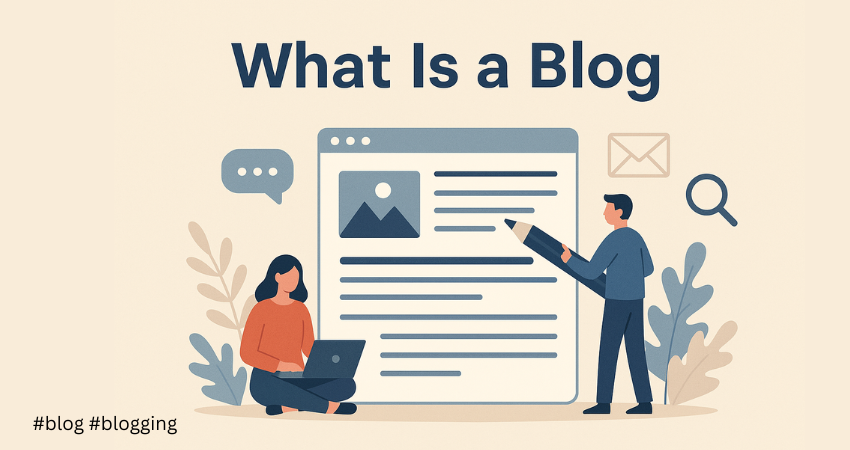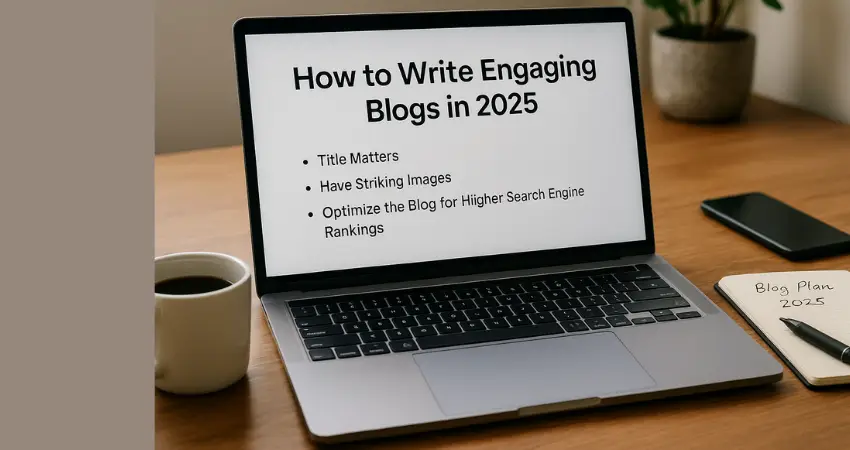What Is a Blog?

You’ve probably come across blog posts while Googling something simple—like “how to write a pitch email” or “best tools for freelance writers.” But have you ever paused to think, what exactly is a blog? Is it just another form of writing? Or is it something more? For many freelancers, small businesses, and personal brands, blogging is more than just publishing articles. It’s a tool to share insights, attract readers, showcase expertise, and yes—build an income stream. And if you’re just starting out or switching lanes in your writing career, understanding the purpose of a blog (and how it’s different from content writing) can make all the difference. This post is your beginner-friendly guide to what blogging really is, how it fits into the broader content landscape, and the 9 types of blogs you should know before hitting “publish.” Key Takeaways A blog is your digital voice. It helps you connect with your audience, showcase expertise, and grow your brand or career. Blogging isn’t the same as content writing. Blogs are one form of content writing—more personal, educational, and story-driven. Choosing the right blog type matters. Knowing your blog’s purpose—whether it’s niche, personal, or professional—helps shape your content and attract the right readers. So, What Is a Blog? A blog is a regularly updated section of a website—or a standalone site—where individuals or businesses publish content in the form of articles (called blog posts). These posts are usually focused on a specific topic or theme, and are written in a conversational, informative, or storytelling tone. At its core, a blog is a tool for: Sharing ideas or experiences Educating or guiding a specific audience Building credibility in a chosen field Attracting traffic through search engines and social shares Unlike static web pages, blogs are dynamic—they grow with time, adapting to the writer’s voice, goals, and audience needs. In plain terms: A blog is your digital space to talk to your audience. It could be about content strategy (like here on mayapillaiwrites.com), writing tips, branding advice, or simply documenting your journey as a freelancer. How Blogging Is Different from Content Writing Let’s clear something up—blogging and content writing are not the same, even though they often overlap. Content writing is a broader umbrella that includes all types of written material created for digital platforms: website copy, product descriptions, newsletters, social media captions, case studies, and more. Blogging, on the other hand, is a specific type of content writing that typically focuses on educating, informing, or engaging an audience through longer-form articles published on a blog section of a website. While content writing is often structured for conversion or performance (e.g., getting someone to buy, sign up, or click), blog writing is more reader-centric—it aims to build trust, deliver value, and encourage repeat visits. Blogs allow for a personal voice, storytelling, and perspective that might not always fit in a more formal or transactional piece of content. For example, a blog post might explore “Why Freelancers Should Build a Personal Brand,” while content writing might involve writing a homepage section titled “About Our Team.” Both are essential in a digital strategy—but they serve different goals, formats, and tones. Aspect Blogging Content Writing Goal To inform, engage, or guide readers To market, convert, sell, or explain Tone Friendly, opinion-based, or story-driven Varies—can be formal, persuasive, technical, or concise Format Articles posted on websites Includes blog posts, website copy, emails, product pages, etc. SEO Importance High—especially for traffic Very high across most formats Reader Interaction Common—through comments or shares 9 Common Types of Blogs (with Real-Life Examples) Whether you’re planning to build your authority, grow an audience, or just document your journey, the type of blog you choose will shape your voice, tone, and reach. Here are the most popular blogging types—with examples to help you visualise the possibilities. 1. Personal Blogs These are intimate, reflective spaces where writers share thoughts, life experiences, lessons learned, and personal stories. Examples: Cup of Jo – A lifestyle and motherhood blog that feels like chatting with a friend. Zen Habits by Leo Babauta – Focused on mindfulness, simplicity, and intentional living. Rukmini Ray Kadam’s blog – Indian blogger writing about everyday reflections, writing, and life. 2. Professional or Business Blogs Used by solopreneurs or businesses to position themselves as experts, attract leads, and provide valuable insights to potential clients. Examples: Neil Patel’s Blog – A digital marketing hub for SEO, content, and growth strategies. FreshBooks Blog – Covers productivity, invoicing, and freelance finance management. Mayapillaiwrites.com – Offers guidance to content writers and builds an ecosystem for writers and clients. 3. Niche Blogs These cater to a specific audience or interest area. The more focused the topic, the more targeted the readers. Examples: The Review Hive – A cybersecurity-focused blog covering software reviews and industry updates. Minimalist Baker – Specialises in simple, plant-based recipes for home cooks. Mr. Money Mustache – Focused exclusively on financial independence and frugal living. 4. Affiliate Blogs These blogs earn through commissions by recommending products or services through tracked affiliate links. They often focus on reviews, listicles, or comparison posts. Examples: The Wirecutter (by NYT) – Recommends tech and home products with detailed reviews. TechRadar – Reviews gadgets, software, and tech services with affiliate links. ShoutMeLoud by Harsh Agrawal – Covers blogging tools and affiliate marketing strategies. 5. Educational Blogs These blogs are built to teach, train, and offer actionable resources—especially valuable for service-based businesses or creators. Examples: Copyblogger – Offers lessons on persuasive writing, copywriting, and content strategy. HubSpot Blog – Covers inbound marketing, sales funnels, and CRM education. ProWritingAid Blog – Teaches grammar, editing techniques, and writing best practices. 6. News and Commentary Blogs These keep readers up to date with trends, current events, or offer strong viewpoints on recent happenings in a particular industry. Examples: Search Engine Journal – News on Google algorithm updates and digital marketing. TechCrunch – Tech startup news and industry trends. Cybersecurity News section on The Review Hive – Covers ransomware, scams, and breach reports
How to Write Engaging Blogs in 2025

Engaging blogs are written for different purposes. Some write it to share knowledge. Others to make money or to pour out their thoughts. But all blogs are not equal. Some are popular while many are ignored. We look at how to write engaging blogs this year. Title Matters The first thing is to have an interesting or catchy title. For your information, people are looking for different things. Some are looking for knowledge. Certain folk want to do research for a purchasing decision. Some want to find out the best product/service which they will eventually acquire. Put yourself in the reader’s shoes and brainstorm what they need as well as want. This will shorten the timespan to choose the right title and the appropriate content for it. Have Striking Images Including images makes a blog look good and easy to read. You can source your images from free sites. If you can afford it, go for paid sites. In general, paid sites have a wider variety of images and have better quality images than free sites. Do not make the mistake of selecting the first image you come across. Allocate time to go through and shortlist the appropriate and best image for your blog. Optimize the Blog for Higher Search Engine Rankings One important factor is fast loading of the blog. Readers will not wait to read blogs that take too much time to load. Make sure that your blog is responsive. To put it simply the blog should look good as well as easy to read across multiple devices. Today most people use their respective smartphones to do various activities including reading blogs. Avoid keyword stuffing. The blog should have a title that is high in demand. The focus keyword should be included in the title, sub-headings, a few times within the blog as well as in the meta description. Use a quality hosting platform for your website. The reason being your blog will load faster and there will be minimal downtime. Other advantages of using a quality hosting platform are stellar customer support and ease of publishing the blog. Also, you can edit the blog conveniently with little or no technical knowledge. Ease of Readability Do not use bombastic language and obscure words. Use simple words known to most readers. Offer translation to cater to readers familiar with languages other than the one the blog is written in. Have relevant sub-headings for paragraphs that readers can scan and decide whether to read that particular paragraph or not. Use short as well as simple sentences. It is a good practice to use active voice instead of passive voice in the blog. Each paragraph should be short and not too big. Organizing the content will surely help readability and scale up popularity. Edit Well Use tools such as Grammarly to spot and rectify spelling mistakes, grammatical errors as well as incorrect punctuation. It is a good practice to proofread the blog at least twice to make sure the blog quality is satisfactory. Have a fresh pair of eyes to examine the content. This is because another person will have a different perspective and catch errors you have missed or overlooked. Have both Internal Links and External Links Include a few internal links in the blog. The links could offer additional information or in-depth explanations. Do not have too many links as this will make the blog look cluttered and confuse the reader. Include a few external links to authoritative sites. This will boost credibility as well as ramp up search engine rankings for the blog. A Final Note Make sure your blog delivers real value, is easy to read, and visually appealing. Once it’s live, promote it across platforms, respond to comments, and give credit where it’s due. Consistency, quality, and engagement are what turn a casual reader into a loyal follower. Need help? We are there—whether it’s refining your content, optimizing for SEO, or brainstorming ideas. Start writing with purpose, publish with confidence, and watch your blog grow in 2025.
